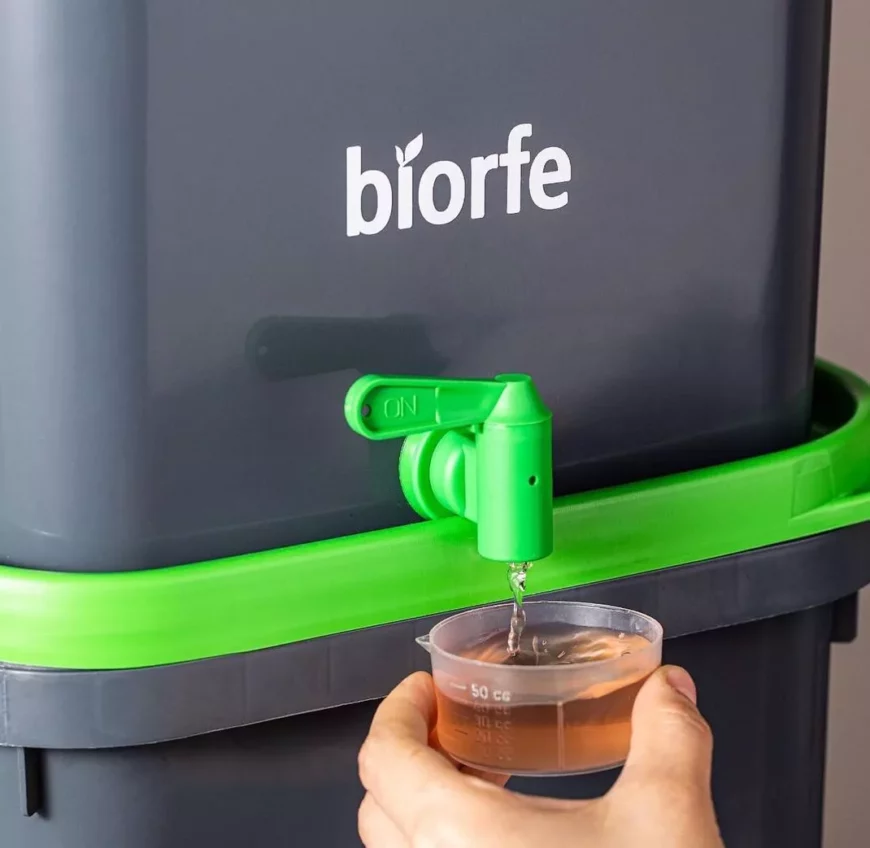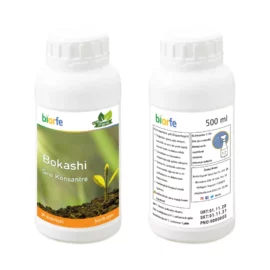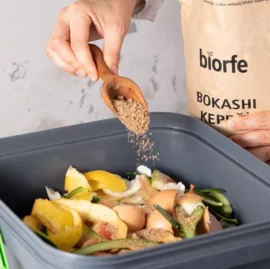Sürdürebilir Yaşam için artık gıda atıklarımızı da çöpe atmıyoruz. Bokashi Kompost yöntemi ile kompost yapmak gerçekten kolaymış. Peki Bokashi Kompostu Nedir? Birçok önemli faydası olan kompost yönteminin tüm detaylarını sizlerle paylaşıyoruz. Bu yazımızda Evde Kompost Nasıl Yapılır? sorusunun cevaplarını çok detayları bulacaksınız.
Sorularımızı Biorfe (Biyolojik Organik Fermentasyon) kurucusu Ziraat Mühendisi Hasan İlgen’e sorduk.
Bokashi Kompostu Nedir?
Bokashi, Japonca’da “fermente olmuş organik madde” demektir.
Bokashi bir soğuk kompost yapım yöntemidir. Bokashi kompost kovasına atılan organik mutfak atıkları, üzerlerine ilave edilen Yararlı Mikroorganizmalar sayesinde fermantasyona uğrar.
Bokashi yapımı sırasında, kompost kovasının içerisine atılan mutfak atıklarının görünüşleri fazla değişmeyecektir fakat iç yapıları değişikliğe uğrayacak ve fermante olmak suretiyle turşulaşacaktır.
Fermantasyon sürecinde, organik maddelerin hücre zarı parçalandığı için toprağa gömüldüğünde büyük bir hızla dönüşerek kompostlaşırlar.
Bokashi Kompostu Evde Nasıl Yapılır?
- Bokashi yapımına başlamak için bir kompost kovası seti edinmeniz ya da kendiniz yapmanız gerekir.
- Bokashi sisteminin doğru çalışabilmesi için yararlı mikroorganizma sıvısına ihtiyacınız olacak. Bu sıvı içerisindeki yararlı mikroorganizmalar sayesinde kokuşma ve böceklenme olmaz… Yararlı mikroorganizma sıvısı %100 organiktir ve spreyleyerek kullanılır. Sıvıyı Biorfe’den temin edebilir ya da evde kolaylıkla kendiniz yapabilirsiniz. Mikroorganizma sıvısını turşu kepeği olarak yapmanız da mümkün.
- Kompost kovanız ve yararlı mikroorganizma sıvınız hazır olduktan sonra yapacağınız tek şey mutfaktaki organik atıkları günlük olarak biriktirip, taze taze kompost kovanıza atıp, üstlerine talaş serpip, yararlı mikroorganizma sıvısı sıkmak ya da varsa Turşu Kepeği serpmek…
- Tüm bu işlemlerden sonra kova içerisinde bulunan sıkıştırma kapağıyla atıklar iyice sıkıştırılır ve kompost kovasının hava almayan kapağı sıkıca kapatılır. Kompost kovaları direk güneş ışığı almayan oda sıcaklığında bir köşede konumlanır ve biriktirilen atıklar günde tek seferde küçük parçalara ayrılıp kompost kovasına atılır. Fermantasyon sürecinin bozulmaması için sistemin olabildiğince az hava alması çok önemlidir.
- İçerisine attığınız atık durum ve miktarına, atılan atıkların küçültülme ebatlarına, kovaların bulunduğu ortamın sıcaklığına bağlı olarak 15-20 gün sonunda kovanızdaki tahliye musluğundan Bokashi alt suyunu almaya başlarsınız. Bu su bitkileriniz organik için organik sıvı gübre niteliğindedir (1’e 100 oranında klorsuz su ile seyrelterek) ve yine bu sıvı koku yapan gider borularına döküldüğünde kokunun yok olduğunu göreceksiniz.
- Elde ettiğiniz Bokashi alt sularını buzdolabında, ağzı kapalı bir şekilde kötü koku ve renk değişimi olmadığı sürece saklayabilirsiniz. Kötü kokan Bokashi alt suları bozulmuş demektedir ve kullanılmaz. Mümkünse kova musluğundan alındığı gün kullanılması tavsiye edilir.
- Kompost kovanız her gün bu işlemleri izleyerek tam doluma ulaştırdıktan sonra ağzı kapalı bir şekilde yine direk güneş ışığı almayan bir yerde 15 gün fermente olması için bekletilir.
- Tam doluma ulaştıktan sonra geçen 15 günlük fermantasyon sürecinin sonunda kova içerisindeki komposttu tamamen toprağa dönüşmesi için 20-30 cm derinliğindeki açtığınız çukura ya da büyük derin saksılara gömmeniz gerekir. Gömdüğünüz bu posa 2 ay sonra tamamen kompostlaşacak ve üzerinde bitki yetişmeye başlanacaktır.
15 gün sonra elde ettiğimiz kompostu nerede kullanabiliriz?
Bahçeli evi olanlar direk bitki ekip diktikleri yerlere ya da ağaçların taç izdüşümlerine açılan çukurlara gömebilir.
Bahçesi olmayan apartman dairesinde yaşayanlar da büyük saksılara gömebilir ya da yaşadıkları apartman site vs. bahçesine gömülebilir.
Oda olmaz derseniz yürüyüşe, pikniğe, gezmeye gittiğiniz zaman herhangi bir yere gömerek doğaya hediye edebilirsiniz.




Comments11
Merhaba, şu ana kadar 1 sefer kovayı doldurdum. Şuan 2. Deyim Ancak şu ana kadar kokmayan sıvı elde edemedim. Hatta kapak kurt dolu. Attıklarım ise yumurta kabuğu diğer gıda kabukları , yeşillik marul gibi şeyler … Biriktirdiğim bile bu kadar kokmuyor . Bir yerde bir hata var . Bulmama yardımcı olur musunuz? Teşekkürler
A) Kovanız direkt güneş alan yerde ise böyle bir problem olmuş olabilir.
B) Kapağı tam kapatıp kovanın hava almamasına dikkat ediyor musunuz?
C) Musluktan gelen bokashi sıvısını düzenli olarak her gün alıyor musunuz?
Kompost kovasını doldurmaya başlayalı 15-20 olmuştur,kovanın yarısından fazlası doldu ama bokashi sıvısı gelmiyor, kovayı biraz eğiyorum ama yine de gelmiyor.Önceki kendi yaptığım kovadan yarısı dolduğunda sıvı gelmeye başlamıştı.Şimdi neden böyle olmuş olabilir
Merhaba, yorumunuz ve sorunuz için teşekkür ederiz. Bokashi sıvısının oluşumu birkaç faktöre bağlıdır. Önceki kendi yaptığınız kovada daha erken sıvı oluşmuş olabilir, ancak her kompost süreci farklı gelişebilir. İşte birkaç olası sebep:
Atık türü: Eğer kovanıza eklediğiniz gıda atıkları daha kuruysa, sıvı oluşumu gecikebilir. Meyve ve sebze gibi su oranı yüksek atıklar sıvı üretimini artırır.
Bokashi kepek miktarı: Yeterli miktarda bokashi kepek eklenmesi süreci hızlandırabilir. Az kepek kullanımı fermantasyon sürecini yavaşlatabilir.
Sıcaklık ve ortam koşulları: Bulunduğu ortamın sıcaklığı ve nemi süreci etkileyebilir. Daha sıcak ve nemli ortamlarda sıvı oluşumu hızlanabilir.
Kovanın sızdırmazlığı: Kovadaki hava sızdırmazlık durumu sıvı üretimini etkileyebilir. Eğer kapak tam kapanmıyorsa fermantasyon süreci düzgün çalışmayabilir.
Benim iki seferdir aldıgım su hep bulanık renkte ve korkunc kötü kokuyor, acaba yanlış birsey mi yapıyorum. Ne atmamak lazım, mesela biz hiç narenciye koymuyoruz
Filtre kahve bu şekilde koku yapabiliyor. Aşağıdaki noktalara dikkat ediniz:
· Sıvının her gün düzenli olarak alınmasına özen gösterin.
· Kapak açık kalmasın.
· Bozulmuş ya da küflenmiş gıdalar atmayınız.
kompostum mis gibi sirkeli turşu gibi kokuyor sorun yok bence,
Ancak alt suyu köyü kokuyor üç gündür su oluştu ve her gün aldim.
Kompostumun içine kepek yerine kıyılmış kuru ot atabilir mıyım.
Bir diğer sorum da şu; kuru hayvan gübresi komposto konulabilir mi?
Sıvılı olan modelde kuru ot atılabilir. Kepek yerine olmaz, çünkü kepek içinde ayrıca mikroorganizmalar bulunmaktadır. Hayvan gübresi atılabilir.
Merhaba, kovamiza cekirdek vb kabukları atabiliyor muyuz?
Kova içerisine çekirdek vb. kuruyemiş kabukları atılabilir. Ancak bunlar fermente olmayacağı için sisteme faydası veya zararı olmayacaktır.